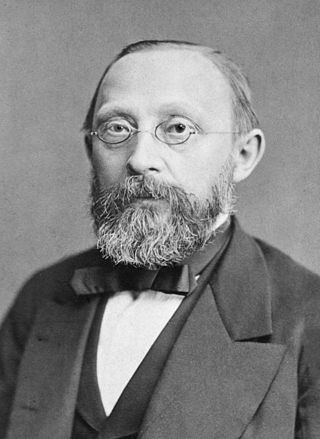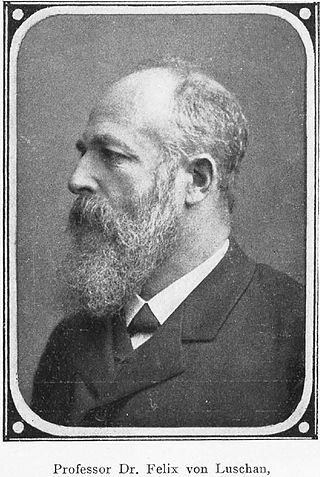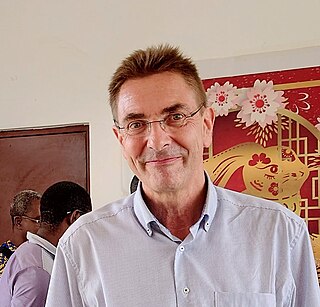Related Research Articles

Wittenberg, is the fourth-largest town in Saxony-Anhalt, Germany. Wittenberg is situated on the River Elbe, 60 kilometers (37 mi) north of Leipzig and 90 kilometers (56 mi) south-west of Berlin, and has a population of 46,008 (2018).

Rudolf Ludwig Carl Virchow was a German physician, anthropologist, pathologist, prehistorian, biologist, writer, editor, and politician. He is known as "the father of modern pathology" and as the founder of social medicine, and to his colleagues, the "Pope of medicine".

Steglitz-Zehlendorf is the sixth borough of Berlin, formed in Berlin's 2001 administrative reform by merging the former boroughs of Steglitz and Zehlendorf.

Anton Wilhelm Amo or Anthony William Amo was a Nzema philosopher from Axim, Dutch Gold Coast. Amo was a professor at the universities of Halle and Jena in Germany after studying there. He was brought to Germany by the Dutch West India Company in 1707 and was presented as a gift to Dukes Augustus William and Ludwig Rudolf of Brunswick-Wolfenbüttel, being treated as a member of the family by their father Anthony Ulrich, Duke of Brunswick-Wolfenbüttel. In 2020, Oxford University Press published a translation of his Latin works from the early 1730s.

Felix Ritter von Luschan was a medical doctor, anthropologist, explorer, archaeologist and ethnographer born in the Austrian Empire.

Oscar Rudolph Neumann was a German ornithologist and naturalist who explored and collected specimens in Africa. He fled via Cuba and settled in the United States to escape Nazi persecution of Jews. Neumann's starling and several other species are named after him.
Konrad Theodor Preuss was a German ethnologist. He was chairman of the Lithuanian Literary Society (1890–98).
Karl Eduard Robert Hartmann was a German naturalist, anatomist and ethnographer.

Albert Grünwedel was a German Indologist, Tibetologist, archaeologist, and explorer of Central Asia. He was one of the first scholars to study the Lepcha language.

The Museum of European Cultures – National Museums in Berlin – Prussian Cultural Heritage Foundation came from the unification of the Europe-Department in the Berlin Museum of Ethnography and the Berlin Museum for Folklore in 1999. The museum focuses on the lived-in world of Europe and European culture contact, predominantly in Germany from the 18th Century until today.

Eckhard Unger was a German assyriologist.
Carsten Niemitz is a German anatomist, ethologist, and human evolutionary biologist.
The Berlin Society for Anthropology, Ethnology, and Prehistory is a learned society for the study of anthropology, ethnology, and prehistory founded in Berlin by Adolf Bastian and Rudolf Virchow in 1869 as the Berlin Anthropological Society.

Benno Wolf was a German judge and a pioneer speleologist. He was a co-founder of the German Society for Mammalogy and has been considered one of the founders of conservation in Prussia. He did the essential preparatory work for the German Reichnaturschutzgesetz (RNG) of 26 June 1935 that for the first time in Germany regulated the official issues of nature conservation, defined protection zones and introduced the concept of landscape protection area. The Nazi government arrested him for having Jewish ancestry and he died in the Theresienstadt concentration camp.

Else Hertzer (1884–1978) was a 20th-century German artist representing the German Expressionism Movement. Her later works became more abstract.
Julius Riemer was a German factory owner, natural history and ethnological collector and museum founder.
Georg Pfeffer was a German anthropologist. Born in 1943 in Berlin to a German sociologist father and a British mother, he was schooled in Hamburg. In 1959, he moved to Lahore with his family, and studied at the city's Forman Christian College for 3 years. Later, he moved back to Germany and studied at the University of Freiburg where he also completed his Ph.D.
Wilhelm Emil Mühlmann was a German ethnologist who served as Professor of Ethnology at the University of Mainz and Chair of Ethnology at the University of Heidelberg.

The Museum of Municipal Collections in the Zeughaus is an interdisciplinary exhibition building in Wittenberg that presents objects from archaeology and urban history, as well as natural history and ethnology. The director of the museum is Andreas Wurda.

Hans Peter Hahn is a German ethnologist, member of the board of the Vereinigung für Afrikawissenschaften in Deutschland and program officer of the 'Franco-German Master of Arts : Ethnology and its German-French perspectives'.
References
- ↑ Irina Steinmann (2016-07-08). "Zeughaus - Berliner shows for the first time rare wooden figures of West African people". Mitteldeutsche Zeitung . Retrieved 2018-12-30.
- ↑ Andreas Schlothauer: Nils Seethaler. Kunst & Kontext 23 (2022), p. 80.
- ↑ Berliner Morgenpost . November 23, 2019, page 9: Willkommen Haifa Amalie
- ↑ Irina Steinmann: Stadt-Museum Wittenberg/Expeditionen in die Grauzone Riemer. In: Mitteldeutsche Zeitung , 11 May 2019.
- ↑ Irina Steinmann: Nils Seethaler hat zur Person Julius Riemer geforscht. In: Wittenberger Sonntag 11 May 2019.
- ↑ Nils Seethaler: Für Virchow unterwegs – Schädelsammler in Australien. In: Mitteilungen der Berliner Gesellschaft für Anthropologie, Ethnologie und Urgeschichte. Band 35, 2014, S. 79–90.
- ↑ Hilary Howes (2016-11-15). "Provenance Report" (PDF). www.aga.org.au. Berlin Society for Anthropology, Ethnology and Prehistory (BSAEP). Retrieved 2018-12-30.
- ↑ Uta Kornmeier (Rezensentin von) (April 2013). "Sammeln und Bewahren, Erforschen und Zurückgeben – aus der Kolonialzeit in akademischen und musealen Sammlungen". H-net.org. H-Soz-u-Kult, H-Net Reviews. Retrieved 2018-12-30. http://www.zfl-berlin.org/tl_files/zfl/downloads/projekte/schaedelbasiswissen/Rez_Human%20Remains.pdf (30 December 2018)
- ↑ Deutscher Museumsbund (2013): Empfehlungen zum Umgang mit menschlichen Überresten in Museen und Sammlungen https://www.museumsbund.de/wp-content/uploads/2017/04/2013-empfehlungen-zum-umgang-mit-menschl-ueberresten.pdf (retrieved 30 December 2018).
- ↑ DER SPIEGEL (30.09.2011): Rückgabe von Kolonialzeit-Schädeln endet im Streit https://www.spiegel.de/wissenschaft/mensch/berliner-charite-rueckgabe-von-kolonialzeit-schaedeln-endet-im-streit-a-789434.html. Archived 2022-01-21 at the Wayback Machine
- ↑ David Bruser: The untold story of four Indigenous skulls given away by one of Canada's most famous doctors, and the quest to bring them home. Toronto Star: Article of December 17, 2020.
- ↑ Nils Seethaler: Das Charité Human Remains Project – interdisziplinäre Forschungen und Restitution menschlicher Überreste. In: Mitteilungen der Berliner Gesellschaft für Anthropologie, Ethnologie und Urgeschichte, Band 33, 2012, S. 103–108.
- ↑ Matthias Glaubrecht, Nils Seethaler, Barbara Teßmann, Katrin Koel-Abt: The potential of biohistory: Re-discovering Adelbert von Chamisso's skull of an Aleut collected during the "Rurik" Expedition 1815–1818 in Alaska. Zoosystematics and Evolution 89 (2), 2013, S. 317–336.
- ↑ Nils Seethaler: Diskrepante Erklärungsansätze in Ethnologie und evolutionärer Psychologie zum Phänomen der bildenden Kunst. In: Benjamin P. Lange, Sascha Schwarz: Die menschliche Psyche zwischen Natur und Kultur. Lengerich 2015, S. 74–82.
- ↑ Benjamin P. Lange, Nils Seethaler: Die Literaturströmung des Sturm und Drang aus evolutionärer Perspektive. In: Benjamin P. Lange (Hrsg.), Sascha Schwarz (Hrsg.): Die menschliche Psyche zwischen Natur und Kultur. Pabst Publishers, Lengerich 2015.
- ↑ MVE-Liste: 11. Jährliche Tagung der MVE-Liste - Menschliches Verhalten in evolutionärer Perspektive (03.05.2013) https://www.yumpu.com/de/document/view/13934965/11-jahrliche-tagung-der-mve-liste-menschliches-verhalten-in- (retrieved 29 December 2018).
- ↑ Irina Steinmann: Ausstellung im Zeughaus: Lobi bleiben in Wittenberg. In: Mitteldeutsche Zeitung (30.12.2016).
- ↑ Nils Seethaler: Von der Privatsammlung zum Museumsforum: Vergangenheit, Gegenwart und Zukunft der Julius-Riemer-Sammlung in Wittenberg. Kunst & Kontext 23 (2022), p. 34
- ↑ Karina Blüthgen: Finissage im Zeughaus: Seit es Menschen gibt, werden Dinge verehrt. In: mz-web.de, 22 April 2018 (retrieved 29 December 2018).